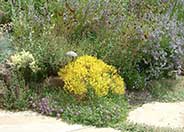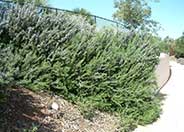
Common name:Pink Gaura
Botanical name:Gaura lindheimeri 'Siskiyou Pink'
Pink Gaura is a profusely flowering perenial that grows to 4' tall. It has pink buds that open to showy pink and white flowers in spring and summer. Accepts full sun or partial shade.

Common name:Ferned-Leaved Tickseed
Botanical name:Bidens ferulifolia 'Goldmarie'
Tickseed grows 14'-18" tall. It is a heat tolerant variety that is perfect for cascading, bright color in baskets, containers, and window boxes. Finely divided foliage is covered with gold, single flowers. It blooms until first frost. Plant in full sun. It needs well-drained soi.

Common name:Rosemary
Botanical name:Rosmarinus officinalis
Rosemary is hardy in full sun areas where winter temperatures do not drop below 10 degrees F. They can be grown in a clay pot with well-drained, porous soil in bright indoor light, and will also flourish on the backporch in spring, summer and fall. Its beautiful, slowly trailing stems and shiny slender leaves are perfect for showing off the small, light blue flowers that blossom in the summer.

Common name:Pink Mexican Evening Primrose
Botanical name:Oenothera speciosa 'Roseum'
Oenothera speciosa 'Rosea' is a perennial ground cover. It grows 10"-12" high, with profuse showing of 1.5" wide rose pink blooms in summer. Flowers open in daytime and stems die back after bloom. It can be highly invasive.

Common name:Sundrops
Botanical name:Calylophus hartwegii
This low-growing perennial grows 1' tall and 3' tall; it has woody stems with bright green leaves. It produces large, lemon yellow flowers that are up to 4" across and bloom spring through summer and possibly through fall, depending on weather conditions.
Maintenance Tips
Calylophus hartwegii is a soft-textured, low-growing perennial with bright yellow flowers. It only grows 12" tall and up to 3' wide. It is very fast growing in the late winter and early spring, and then it is covered with flowers from mid-spring until fall if the weather is ideal. In the fall, when the days start to get shorter and the rains begin, this plant can decline. The root system will stay intact, but the flowering stops, and the foliage will completely die back. This plant benefits from hard pruning, taking the foliage, and branching almost down to the ground. Don't expect any new growth to emerge until the days start to get longer and warm up. The foliage will start to emerge, and the plant's quick growth and blooming cycle will return.
Common name:Hidcote English Lavender
Botanical name:Lavandula angustifolia 'Hidcote'
This is a slow growing lavender that grows to 2-3' tall with deep purple flowers. It is drought tolerant and attracts hummingbirds and butterflies.
Maintenance Tips
Lavandula angustifolia 'Hidcote' is a smaller hybrid of the English Lavender and is often found in California native gardens. It is a woody shrub with a nice round form. It grows 2-3’ tall and wide and has flower stalks that emerge above the foliage in the spring. The foliage and blooms are very fragrant and are a magnet for bees and butterflies. To keep the maintenance as low as possible, plant it in a sunny location with the space to reach its full mature size. Once the flowers have faded, the spent stalks can be deadheaded to keep the shrub looking tidy and encourage additional flowers. This shrub can take a more aggressive hedging, cutting back by about a third in the winter to keep the round shape.
Photographer: GardenSoft
Incorporate compost 6" into your soil to retain water, reduce compaction, feed earthworms, and provide valuable nutrients to your plants.
Develop healthy soil for plants that are vigorous and naturally pest-resistant.